NASA Announces New Deadline for ARM Program
NASA specified the astronauts landing time on an asteroid - more precisely, the timing of the two astronauts visiting the cobblestone at the moon
The announcement of the NASA plans for the ARM program (Asteroid Redirect Mission - the mission to redirect the asteroid) in our press did not arouse much interest.
The essence of the news in our media: the timing of the launch of the tug for the flight to the asteroid and the seizure of the cobblestone there (to transport it to the orbit of the Moon) are now shifted from 2019 to 2021, the astronauts' flight dates to this cobblestone have shifted from 2024 to December 2026 .

')
The reason for the lack of broad interest is simple: how many times did NASA change the time frame? No one is interested anymore ...
The trend in the timing and uncertain financing have already been discussed - this was already described in detail in the Cosmonautics section (using the example of the development of the Orion spacecraft) in 2014 .
Then the manned flight shift to 2024 seemed like a flop.
Now he “failed” for another couple of years into the future ...
In the American media, there are hints that recent shifts in dates are also related to “sabotage” by the lower house of the US parliament, which require the roll-out of the ARM project and reorient NASA efforts to the Moon (work on its surface). I already wrote about this here .
So, the head of the ARM program Michele Gates ( Michele Gates ) was noted in the article SpaceNews with her hints:
Although she did not explicitly mention the language of communication of the House of Representatives in her speech at the conference, she hinted at the challenges the program faced. " The process is even more politically biased than I have ever seen ," she said about the whole procedure for knocking out money for the NASA program.
In the US media, there are messages that are more important than NASA’s deadlines and struggle (still impressed by the goals set by President Obama in 2010 ) and a group of members of parliament (still hoping to deploy NASA to lunar missions). These are three news items:
Firstly: the target of the ARM program (the asteroid itself, from where the tug will take the cobblestone) has not yet been selected - it will be determined at the end of 2020 or at the beginning of 2021!
Now NASA is defined in the list of 4 asteroids: Itokawa , Bennu , 2008 EV5 (it is not in Russian on Wikipedia), 1999 JU3 . On the first asteroid (or rather, a pile of garbage, which had closed up into something like an asteroid) under gravity, there are exactly the cobblestones of the right size - there was a Japanese Hayabusa spacecraft , took samples of the soil from there and filmed landscapes.
Secondly: The rocket for launching the tug has not yet been selected, 4 options are being considered, according to new data from August 1, 2016 - 3 options, two of which have not yet flown.
Thirdly: The second part of the ARM program, the Asteroid Redirect Crewed Mission (ARCM) manned mission, is likely to be based on the good old EM-2 mission to test the Orion. Those. instead of a planned test of the Orion in the first manned mission with a full crew in the Moon’s orbit (called EM-2) there will be a flight to the cobblestone. Two missions in one bottle - direct savings.
And like the crew in this flight will be cut from 4 to 2 people. However, the safety of the crew, who will perform such a complex mission on the Orion ship, which has not been proven in the case, will be questionable.
SLS and Orion - test flights
Here, one cannot do without an excursion into the history of the future super-heavy SLS rocket and the Orion ship:
To test them, NASA first conceived one unmanned mission: Exploration Flight Test 1 or EFT-1 to launch the Orion spacecraft (using the usual Delta IV Heavy rocket , since the SLS was not ready yet) to a high orbit. Then the ship "Orion" returned and entered the atmosphere at a speed of 8.9 km / s. This mission was successful on December 5, 2014.
According to NASA's plan, two more missions will take place precisely to test the ligaments of the SLS and Orion rocket-ship. In 2012, it was decided: there will be two flights in the near-moon space: one unmanned - SLS-1 (EM-1 - Exploration Mission - Research Mission), one with 4 astronauts - SLS-2 (EM-2).
SLS-1 / EM-1: unmanned flight of the moon by the ship "Orion" in 2017 or 2018
In the fall of 2018, this mission will begin with the launch of a new SLS rocket, with the Orion spacecraft to the Moon.
It is alleged that the delay in the fulfillment of this mission is caused by the fact that both the SLS rocket and the Orion spacecraft were developed just in case for delivering cosmonauts to the ISS and for evacuation from there . But for this they are too expensive and large - it’s like hammering furniture studs with a sledge hammer. For flights to the ISS, they will most likely use a rocket and a ship from a private company SpaceX: Falcon 9 and Dragon. Bill Gerstenmaier himself, the head of NASA's manned programs, insists that at first there were no plans to use the Orion as a transport to the ISS!
Removal of the ship on the way to the Moon can be carried out by a whole set of different candidates for the role of the upper 3rd stage (upper stage). These are the top rungs from Delta IV or Atlas missiles.
The main thing is that this stage, named in the Interim Cryogenic Propulsion Stage Project (ICPS - Interim / Intermediate Cryogenic Reactive Stage), should be paid for and delivered to the space center. Kennedy (Florida) no later than Q4 2016.
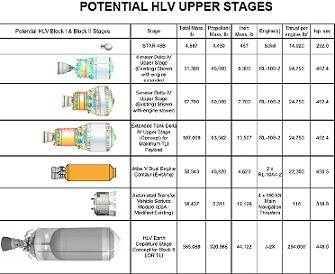
The favorite among the candidates is the Delta Cryogenic Second Stage (DCSS - in the picture below) - this is the 2nd stage of the Delta IV Heavy rocket, weighing about 30.7-32.4 tons.
About the very rocket Delta IV Heavy in the section Astronautics recently was an interesting material .
This additional stage with the aggregate compartment (with a total weight of about 24.2 tons) from a very inconvenient time orbit (parameters of 1800 x 93 km chosen for safe removal of the second stage of SLS from orbit) to a more normal one. The same stage should provide a delta-V of 3050 m / s for three pulses / corrections (acceleration in each is no more than 2 g), as a result sending a ship (with an additional load in the form of 13 CubeSat mini-satellites) to the Moon. The phases of a passive flight, without engine operation, are 50-270 minutes between the 1st and 2nd pulse, and have not yet been defined between the 2nd and 3rd pulse. This accelerating unit also requires the ability to give a “farewell” impulse in the region of 50 m / s after separation from the Orion, so as not to fly next to it to the Moon, crushing the crew’s nerves with the danger of a collision (at one time in a similar situation many times the third step S-IVB of the Saturn-5 rocket strongly irritated the captain of the Apollo-8 Borman - after a meeting with the command and control center, the ship missed her, and then the command post sent a tank drainage command to the stage, which caused an increase in speed — the stage flew forward) .
Further, Orion itself, using its aggregate compartment (service module) called European Service Module (ESM) , based on the European Automated Transfer Vehicle (ATV) and produced by the European Space Agency (in the form of netting for the use of the ISS), can add a delta -V of about 1340 m / s to its speed.
The flight trajectory at the Moon is also described in detail : after one revolution 100 km from the lunar surface for a gravitational maneuver, the ship flies 60-70 thousand km in a high elliptical orbit beyond the far side of our natural satellite and goes there (it needs a delta V 300 m / s) to the notorious Long-Distance Retrograde Orbit around the Moon (moving along it at a speed of about 0.2 km / s in the opposite direction relative to the Moon's movement around the Earth) and remains on it for 6 days (covering about a third of the circumference of this orbit). Then it also leaves it, using the gravitational maneuver in one revolution at the moon.
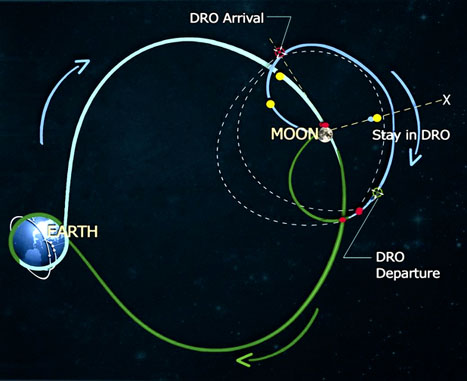
What good is the Far Retrograde Orbit (DRO) in general and the Moon in particular? It is stable and to go from it to the Lagrange points L1 or L2 (both slightly inside this orbit) a pulse of only 15 m / s is required. But not a single device has ever been launched into such an orbit.
After leaving the moon, "Orion" rests on a course toward Earth, near the earth the aggregate compartment detaches, and the command compartment enters the atmosphere at a speed of about 11 km / s. Everything is absolutely safe, since there is still no crew on the Orion ship.
SLS-2 / EM-2: just a manned flight into orbit around the moon?
In the original version, the EM-2 manned mission is more difficult and more dangerous: the SLS rocket (with the same third stage / upper DCSS block) will lead the Orion with an aggregate compartment and four astronauts aboard the trajectory to the Moon. There, Orion will move to a high orbit of the Moon, where it will spin for 3-4 days. There is simply not enough fuel for a low lunar orbit. So it was planned quite recently, in 2014–15, dates like “early 2019” were called.
Alas, now the dates have shifted and are not clearly defined. In addition, there were reports that a new version of the third stage, called the Exploration Upper Stage (EUS), was being considered.

This stage is much harder - it will weigh more than 119 tons ! By the way, it is planned to use four old RL10 engines developed in 1963 from the Apollo lunar program . In general, the number of borrowings from that program of the 60s is increasing.
The use of this new EUS 3rd stage was previously discussed only for the next EM-3 mission. The change in the plans is probably due to the idea of combining the EM-2 and the ship’s visit to the cobblestone parked in the Moon’s orbit - after all, the 3rd stage of the ICPS (DCSS from the Delta IV Heavy rocket) simply lacks fuel.
HLO Option: The basic version of the EM-2 mission is called the HLO - High Lunar Orbit (High Moon Orbit).
The usual flight to the moon, then a span over the moon, a braking impulse at an altitude of 100 km above the back side of the moon and an exit to a high orbit with parameters of 100 x 10,000 km (originally, 1000–3000 km were planned). The stay in this orbit is 3-4 days and then the impulse by the engines to reach the trajectory to the Earth. The entrance to the atmosphere of the Earth (after separation of the aggregate compartment) occurs at a speed of 11.2 km / s.

However, other options were considered:
Variant DRO / NRO: Distant Retrograde Orbit (DRO) and halo-shaped orbit at Lagrange (Near Rectilinear halo Orbit - NRO).
In the first variant, a ship with 4 crew members maneuvers by the Moon enters the Far Retrograde Orbit with a radius of about 60-70 thousand km. Just like in the EM-1 mission (see above), only with the crew. If NASA decided to combine EM-2 and a visit to the cobblestone parked in this orbit, then this sub-option inevitably becomes the basis of the entire EM-2 mission.

In the second sub-version, NASA thought about flying into a halo-orbit (Near Rectilinear halo Orbit - NRO) at L1 Lagrange or at L2 Lagrange - more about these “orbits” and about their possible future use .
But for all these previously unrealized ideas, complex and long maneuvers are required, with autonomy of at least about 25-26 days, which is more than the usual autonomy of 21 days, provided for by the Orion ship design.
Hybrid Variant: A hybrid flight of 3 elliptical orbits around the Earth.
The most conservative and safe (in terms of engine failure of the Orion ship) option. A sequential transition between three high elliptical orbits around the Earth is conceived, with engines checked before each new launch.
The first orbit is parking, then the launch of the third-stage engine (upper stage). When the second orbit is reached with parameters of 391 x 71333 km, the Orion with its aggregate compartment is separated from the 3rd stage (upper stage). The team waits in this orbit 24 hours, checking all systems. If everything is in order, then an impulse is given at the perigee and the ship flies towards the Moon, circling it far behind, through the Lagrange point L2 61548 km from the lunar surface. From here, only a weak impulse with a tiny delta V at 77 m / s is needed for pointing to Earth and returning to it.
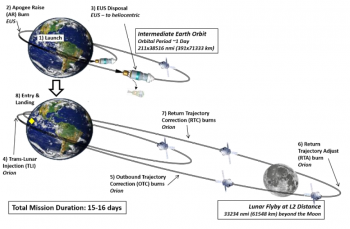
But this option requires 15-16 days to perform and carries an additional risk in the form of increased radiation load on the crew and equipment, as the ship passes several times (and more slowly) through the Van Allen radiation belts . Therefore, this option is not accepted.
How to deliver an asteroid? Tug parameters
NASA has already decided on the basic parameters of the automatic tug . They have not changed for several months already, against the background of other ambiguities this is the most definite part of the program.
In tow, there should be solar batteries with a power of 50 KW and a transformer that raises the voltage to 800 volts to power several ionic engines with tenths of newton (working on the Hall effect, current engine models consume about 4.5 KW and a specific impulse for about 2000 seconds, developed up to 6 KW and a specific impulse up to 3000 seconds [ 1 ]) and at least 10 tons of working fluid for these engines in the form of heavy xenon gas (the better the mass ratio of gas ions to ionization energy, the higher the specific impulse and Engine efficiency). The xenon tank itself is designed for a volume of up to 12 tons of xenon. This is simply an unprecedented margin in the history of astronautics (for both ion engines and xenon) - before that, the largest reserve was 425 kg of xenon on the Dawn satellite . For orientation in tow there will be chemical engines on hydrazine (heptyl). In tow, there will also be a docking hub, so that astronauts can dock their Orion to it.
An interesting detail: this tug is being developed with the possibility of its further use for delivering cargo to accomplish its future mission to Phobos (the satellite of Mars).
Which rocket to launch a tug?
4 options are discussed, according to new data from August 1, 2016 - 3 options: Atlas V version 551 (up to 18814 kg in low orbit), Delta IV Heavy (up to 28790 kg kg in low orbit), Falcon Heavy (up to 54400 kg in low orbit ) and of course SLS (up to 70,000 kg into low orbit). The last two super-heavy rockets have not yet flown, but Falcon Heavy should fly at the end of 2016. It is argued that the use of super-heavy rocket carriers does not greatly increase the mass of the cobblestone delivered, but allows you to launch the tug later and still have time for the target dates (which all the same shift by 2026).
Why did you choose to climb a cobblestone instead of capturing a small asteroid?
One of the reasons for abandoning Plan A (capturing a small, separately drifting asteroid with a diameter of about 10 meters) in favor of Plan B (raising a cobblestone 3-5 meters in diameter with a normal asteroid) was the problem of finding such small targets from Earth .
The second problem is the elimination of the rotation of a small but heavy (1000 ton) asteroid. And the rotation must be controlled, since the solar panels of the tug will withstand (with a probability of 95%) the torque when rotating no more than 2 revolutions per minute. According to the most optimistic calculations, it turned out that even for a 500-ton asteroid to reduce the rotational speed from 1 to 0 rpm in 6 days, you need to spend 12 kg of xenon and another 70 kg of hydrazine. And it is possible during this operation to tear the asteroid holding the inflatable bag.
In option B, there are no problems with rotation: the cobblestone lying on the asteroid's surface no longer rotates. But because of the sophisticated navigation system, approaching and landing on the asteroid, the addition of 6 different manipulators for grabbing the cobblestone, this option costs $ 100 million more, as a NASA representative said in March 2015 . At the same time, the entire cost of the automatic part of the ARM project (tug and its maintenance from the Earth) will remain within the limits of the previously announced amount of $ 1.25 billion (not including the cost of the rocket and launch).
How huge plans shrank to a cobblestone and EM-2 stripped down to two astronauts
Now let's compare the initial plans for the precepts and promises of President Obama in 2010: "We will begin by sending astronauts to an asteroid for the first time in history!" He was called as a term in 2025. About how to fly and land directly on a real asteroid was somehow immediately forgotten, although this would be very useful for training a flight to Mars and disembarking on its satellites (Phobos or Deimos).
Then there was a consistent regression in the plans:
1. Back in September 2013 (only three years ago), the plan to visit an asteroid / cobble in the Moon’s orbit struck with its grandeur : two SLS rocket launches (one cargo, the other manned) with 105 tons of payload on the NOU, with cargo launch into orbit a whole orbital station with a dry weight of 23 tons and a total weight of about 29 tons with a volume of 72 m3 ( Salyut-7 had 90 m3 and weighed less than 20 tons)!
Of course, this is not an orbital station, but a large residential module called DSH - Deep Space Habitat (Habitat for Deep Space), developed based on the experience of the MKS orbital station with the REM (Robotics and EVA Module) module for spacewalks, with space storage spacesuits, gateway and manipulator. Why such a huge residential module? The fact is that at that time the mission was planned very long. In all luxury and scope: 80 days of flight there and 14 days there!
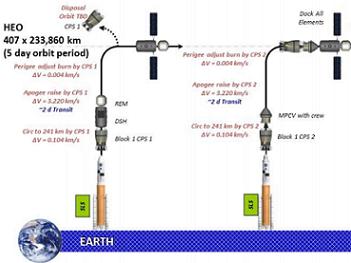
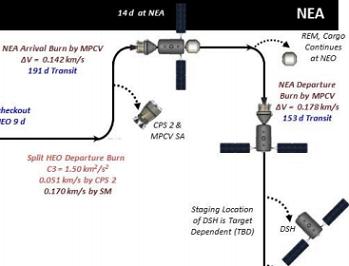
First, the SLS rocket launch launches an empty DSH (together with REM) with the 3rd stage of the Cryogenic Propulsion Stage (CPS) into an intermediate orbit, then this stage leads the module into a high near-earth orbit with parameters 407 x 233860 km (and separated). The module, having deployed solar batteries, waits 121 days for docking in this orbit, while the second SLS rocket with the same 3rd stage and the Orion spacecraft piloted by 4 astronauts is launched from Earth. This bundle flies up to the DSH module, fits in with it. Further, the 3rd stage of CPS with the remnants of its fuel leads this system to the Moon and is separated, and the next correction and deceleration at the Moon is performed by the engine of the Orion ship's aggregate compartment. The flight is very slow - only on the 202 day of the mission (81 days of the manned part) the system flies to the asteroid (more precisely to the cobblestone) in orbit near the moon. There, the crew spends at least 14 days, picking on this cobblestone (during this time, a 3 meter stone can be drilled through!). Before flying to Earth, the ship "Orion" separates the already unnecessary REM module from the residential DSH module and begins a long way home, which lasts 153 days! Two days before entering the atmosphere, the Orion is separated from the residential DSH module. On the last 490 day of the mission (369 day of the manned part!), The Orion detaches its aggregate compartment and enters the atmosphere.
2. Just a year ago, a visit to an asteroid or a cobblestone in the lunar orbit (ARCM mission) was planned as an EM-5 or even an EM-6 flight of the SLS bundle - Orion .
Then they began to optimistically indicate that this will happen during the EM-3. In any case, then even the mission of the EM-5 was planned for 2026. Already then, messages slipped that the crew in such missions would be reduced to 2 people .
Bill Gershtenmayer, head of NASA's manned program, still mentions in his report (on the future flights of the Orion spacecraft) EM-5/6 as the first visit to the cobblestone: “EM-5 and EM-6 missions will be manned missions to asteroids " . And what will happen to the EM-3, what will the astronauts do there? Does he mean additional flights to that same cobblestone already after EM-3? Or instead of EM-3? Or flying to other asteroids?
This article is not explained. Nor are the timelines and objectives of the EM-5 and EM-6 missions explained. Information about them is on Wikipedia: “EM-4 and EM-5 missions are near-moon missions similar to EM-3.” But about EM-6 and nothing is mentioned there.
3. And now, because of problems with the budget, the entire program has narrowed down to the EM-2 mission of the still untested Orion ship: duration of 24-25 days, a flight to the Far Retrograde Orbit at the Moon and a couple of spacewalks for two people , to touch and pick the cobblestone, delivered there by tug ...
It’s a paradox, but at the same time some at NASA because of a leapfrog with deadlines, budget and disputes about choosing the 3rd stage (DCSS, CPS or EUS) even doubt that EM-2 will be a manned mission and believe that it will be just an automatic flight with Check 3 rd stage EUS.
In conclusion, we can say: we must wait for the results of the elections in the United States, after which the next changes can be in the frames and in the plans of NASA. And it will be possible to take all these plans seriously only after the first successful launch of the SLS rocket in 2018.
Source: https://habr.com/ru/post/396717/
All Articles